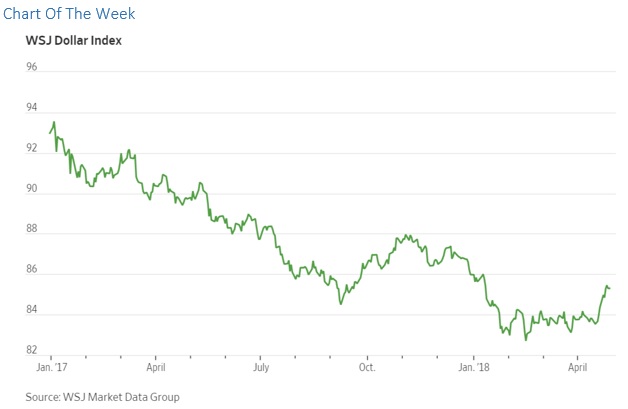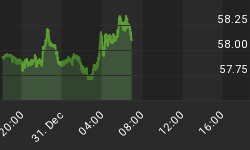Monday, April 30, 2018
Markets up on earnings, peace talks between North and South Korea. A diplomatic breakthrough on the Korean Peninsula has reduced global tension and calmed financial markets. Meanwhile, a spate of strong earnings have sparked a rally in global indices. U.S. Treasury Secretary Steven Mnuchin is visiting China for high-level trade talks, with as much as $150 billion in tariffs on the line. Finally, country exemptions on U.S. steel and aluminum tariffs expire on Tuesday, and U.S. officials have suggested that only some of them will be renewed.

(Click to enlarge)
- The U.S. dollar has lost a lot of value over the past 16 months but has recently clawed back some gains.
- Higher interest rates, strong growth and a deceleration in economic growth elsewhere have worked to the benefit of the dollar.
- Forthcoming data on wage growth could provide another boost because it could increase inflation expectations and spark more rate tightening from the Fed.
Markets
Stocks up on corporate earnings. U.S. stocks started up on Monday on the back of solid corporate earnings. After a rocky start to the year, recent data from the first quarter shows an unexpectedly strong performance for a lot of industries, boosting stocks around the world. There have been 267 companies in the S&P 500 that have reported first quarter results, and nearly 80 percent have reported results that beat analyst expectations. That is higher than the historical average of 64 percent, according to the WSJ and Reuters.
Dollar rallying on U.S. growth. After struggling for much of 2018, the U.S. dollar has rallied on strong economic growth as well as inflation concerns. Interest rate hikes and higher yields on U.S. treasuries after a decade of rock bottom rates are providing a lift to the greenback. Last week, new government data revealed a first quarter GDP annualized growth rate of 2.3 percent, much faster than the 1.8 percent that analysts predicted. At the same time, concerns of a slowdown in Europe have benefited the U.S. dollar. Related: The Five Biggest Bubbles In Stock Market History
Appetite for U.S. debt wanes. Even as the dollar has posted recent gains on the strength of U.S. economic indicators, the WSJ reports that foreign investors are losing their appetite for U.S. debt, which could prompt higher yields and, in the long run, slower economic growth. The timing is not great since the U.S. budget deficit is expected to balloon beyond $1 trillion by 2020, necessitating higher levels of debt issuance.
Commodities
“April 2018 has not been a good month for aluminum globally.” The secretary-general of the International Aluminum Institute, Ron Knapp, said that the aluminum industry “is going to suffer from disruption, distortion and damage.” His comments, made at the World Aluminum Conference in London, stem from U.S. sanctions on Russia’s Rusal, which sparked violent volatility in the global aluminum market. Washington was surprised by the turmoil, and extended the sanctions deadline until October 2018.
Dollar gains, gold loses. The rebound in the U.S. dollar has been bad news for gold. The rally in the greenback over the past three weeks has occurred as gold has lost 3.5 percent of its value. Meanwhile, a potentially historic breakthrough on the Korean Peninsula also played a role. “The signs of detente in the North Korean conflict are also contributing to the lack of solid demand for gold as a safe haven at present,” Commerzbank said in a note. "Gold positions continued to be rolled back as the markets are adjusting portfolios given the increased potential for the dollar to rise in the weeks ahead becomes a reality," said Stephen Innes, APAC trading head at OANDA, according to Reuters.
Commodities the top asset of 2018. Commodities are the top returning asset class so far in 2018, according to Bank of America Merrill Lynch. The commodity sector is posting annualized returns of 22.7 percent year-to-date. If that rate of return holds, it would be the strongest year for commodities in about 15 years. More importantly, commodities still seem undervalued on a cyclical basis, with prices bouncing off of multi-year lows. A series of investment banks have held up the commodities sector as the top investing opportunity for this year.
Energy
Higher oil prices a drag for U.S. corporations. Costs are rising at some key U.S. companies because of higher oil prices. American Airlines Group (NYSE: AAL), for instance, warned shareholders that higher oil prices will hike expenses this year. Those costs will be passed on to the consumer. “I do believe that consumers will pay more,” said American Airlines Chief Executive Doug Parker. Union Pacific (NYSE: UNP) said that fuel expenses jumped by 28 percent in the first quarter, some of which was passed onto customers.
Marathon to buy Andeavor, creating largest U.S. refiner. Marathon Petroleum (NYSE: MPC) agreed to buy Andeavor (NYSE: ANDV) for $23.3 billion. The acquisition will make the combined company the largest independent U.S. refiner. Marathon has assets in the Midwest and Gulf Coast, and the takeover of Andeavor will add refining assets in the U.S. West.
Related: What Does A Billionaire's Bucket List Look Like?
Oil prices dip on rig count. Oil prices started off the week posting modest losses as the markets focused on a potential uptick in U.S. drilling activity. The rig count rose by five last week, hitting a three-year high. “U.S. shale activity is now 30 percent above the peak year of 2014 and the space is still heating up with more drilling rigs being added,” Bjarne Schieldrop, chief commodities analyst at SEB, said in a statement. But the emphasis on the rig count will be brief as other more important factors come into focus. “Overall, there is really only one theme in the market—and that is Iran vs. Trump,” said Ole Hansen, chief commodity strategist at Saxo Bank, according to the WSJ.
Cryptocurrencies
Bitcoin gains, eyes a return to $10,000. Bitcoin gained 15 percent last week, and opened the week just below $9,400. The cryptocurrency is within striking distance of the psychologically important threshold of $10,000, which it hasn’t hit in nearly two months. But a roughly 40 percent gain over the past few weeks has the bulls back on the march.
France cuts cryptocurrency tax rate from 45 percent to 19 percent. France just cut the capital gains rate on cryptocurrency income by more than half, lowering it from 45 percent to 19 percent. France’s Council of State ruled that cryptocurrency profits are “moveable property,” rather than industrial or commercial income. As such, crypto profits are now subjected to a lower tax rate.
NASDAQ CEO warms to cryptocurrencies. Lending credibility to the cryptocurrency sector, NASDAQ CEO Adena Friedman said that the index would look at cryptocurrencies as they begin to mature. "I believe that digital currencies will continue to persist...it's just a matter of how long it will take for that space to mature," Friedman said on CBNC last week. "Once you look at it and say, 'do we want to provide a regulated market for this?' Certainly, Nasdaq would consider it." Meanwhile, other signs point to momentum for cryptocurrencies. NASDAQ announced a collaboration with Gemini, a cryptocurrency exchange. And NASDAQ reportedly has a Bitcoin futures contract in the works, according to Forbes.
By Josh Owens for Safehaven.com
More Top Reads From Safehaven.com:

















